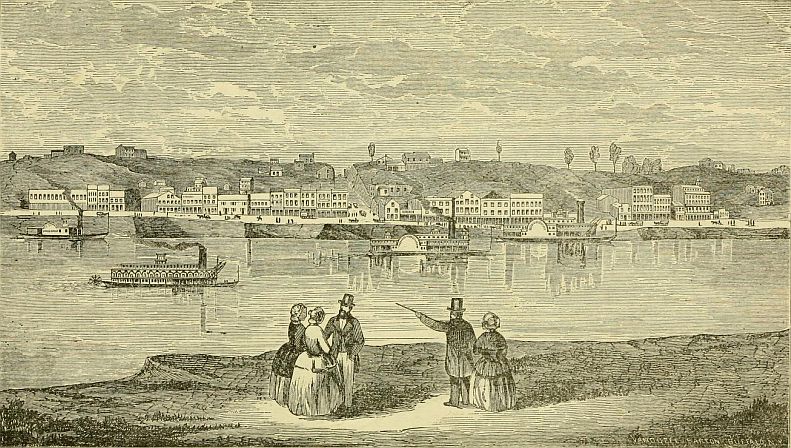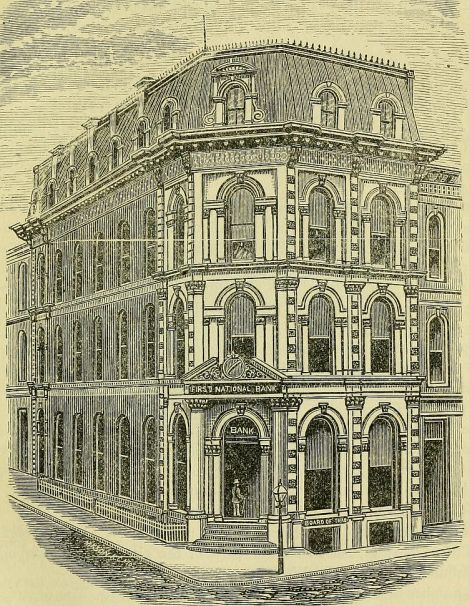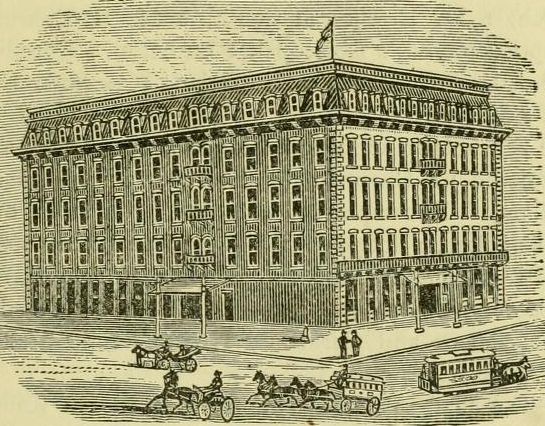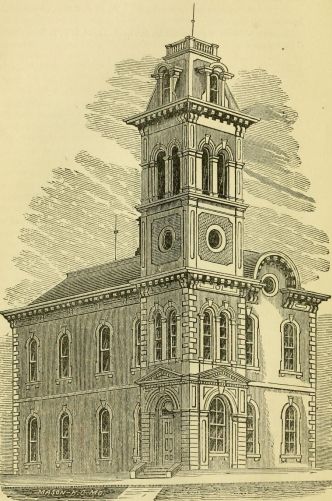Kansas City, Missouri


Kansas City 1855
Kansas City, in the extreme northwest corner of the county, is built up to the line of the State on the west, and
the Missouri River on the north. The present city limits include an area of about 3,600 acres. The population in 1870
was 32,268; present population (estimated) 40,000. A circuit of 5 miles in diameter, including the cities of Westport
and West Kansas City, Armstrong and Wyandotte (the three latter in the State of Kansas) and Harlem in Clay County, would
include a population of over 50,000. The original town tract of 256 acres, was purchased in 1838 at a sale in partition
of the estate of Gabriel Prudhomme, the patentee. The original proprietors were Robert Campbell, William Gilliss, John C.
McCoy, Fry P. McGee, Wm. B. Evans, Jacob Ragan, and Henry Jobe, who, in 1839, laid out into lots about 40 acres of the
tract and sold them at public sale. Owing to a disagreement between the proprietors, this sale was not fully consummated
until April 1846, when a larger area was laid off and sold. Meanwhile some 20 or 30 of the purchasers at the first sale
improved and occupied their lots, and carried on their several avocations. In this last sale considerable public interest
was manifested, and it proved quite a success, the aggregate amount of the sale being over $7,000, and the highest price
bid for any one lot being a little over $200. The proprietors were elated at their extraordinary success, and began to
talk of a city sometime in the dim future, but they had sturdy competitors to contend with in the race for metropolitan
honors. Independence, grown rich with an undisputed monopoly of the commerce of the plains, was disposed to make a death
struggle to retain it, and Westport ridiculed the presumptuous aspirations of her steamboat landing, so the problem
involved in the race to greatness remained unsolved, until the superior natural advantages of Kansas City wrought out
their legitimate results in favor of that natural diverging and concentrating point. Topographically, the old site of the
city was a succession of high ridges and deep gorges, with only one possible way to reach the river landing without
immense labor and cost. The newer portions south of Tenth street, however, comprising more than sixty additions have
an excellent surface. The city is not regularly laid out, but the streets are wide, graded and sewered, provided with
side walks, and lighted with gas.
A. B. Canville, the first merchant, commenced business here soon after 1840; Cahn & Block, with a stock worth $5,000,
in 1843, were immediately followed by E. P. Hart & Company, and Wm. J. Jarboe. Warehouses were built in 1844 by
Francis G. Chouteau and Wm. Chick, the latter being appointed postmaster of the office that year established.
Bent and St. Vrain landed the first cargo of goods shipped from this port to New Mexico in a wagon train. The New
Mexico trade gradually concentrated here, until in 1850 it amounted to 600 wagon loads. In 1853, there were over 300
operators in this trade, and 9,884 freight wagons left this point for Santa Fe, and goods valued at $5,000,000,
The opening for settlement of Kansas Territory in 1854 gave new impetus to trade.
The city was incorporated March 28, 1853. The first city election was held April 18th, and the city government was
organized on the 25th of the same month.
Kansas City Mayors
| 1853 | Wm. S. Gregory | | 1863 | William Bonnefield |
| | Johnston Lykins | | 1864 | R. T. Van Horn |
| 1854 | Johnston Lykins | | 1865 | Patrick Shannon |
| 1855 | John Johnson | | 1866 | A. L. Harris |
| | M. J. Payne | | 1867 | E. H. Allen |
| 1856 | M. J. Payne | | 1868 | A. L. Harris |
| 1857 | M. J. Payne | | 1869 | F. R. Long |
| 1858 | M. J. Payne | | 1870 | E. M. McGee |
| 1859 | M. J. Payne | | 1871 | Wm. Warner |
| 1860 | G. M. B. Maughs | | 1872 | R. H. Hunt |
| 1861 | R. T. Van Horn | | 1873 | E. L. Martin |
| 1862 | M. J. Payne | | 1874 | Smith D. Woods |
A Court of Common Pleas was established in 1855. Northrup & Company opened a bank in 1856, at the time the population
numbered about 1,000, and the taxable property was valued at about $600,000. The city in 1857 expended for grading
embankment, cisterns, etc., the sum of $30,866. Population in 1860, about 4,000; taxable value of property,
about $2,000,000.
During the late civil war the town was occupied as a military post. Most of its business men left, and it emerged
from the contest with no trade and less population than in 1860.
The completion of the Missouri Pacific Rail Road to this point in 1865 gave a new impulse to trade. The building
of the Cameron branch of the Hannibal & St. Joseph Rail Road, and the bridging of the Missouri secured the junction
of several other roads and made Kansas City a great railroad center.
In 1866 actual recuperation commenced, and in the rapid increase of the city in population, in the immense amount of
public and private improvement, and in all the substantial and important interests which go to build up a great city,
it has, perhaps, no parallel in the history of the continent. In four years from that time (viz. 1870) the official
census shows a population of 32,268, being an increase of more than 400 per cent. in four years. The number and cost
of public schools and churches, the magnificent iron railroad and passenger bridge spanning the Missouri, the Exposition
grounds of 90 acres with their adornments, the gas works, the elegant and commodious court house, the hotels, opera
house and blocks of costly business and private dwellings, all attest unparalleled growth. Ten lines of railway
concentrate within her limits, and four other lines are in process of construction, and the citizens of Kansas City, at
least, regard it as a fixed certainty that, as she is now, so she will remain, the great railroad center west of
St. Louis.
The Board of Trade, made up of the leading business men of the city, was organized January 17, 1872. It has been
admitted to membership in the National Board. The president for 1874 is F. B. Nofsinger. The Gas Company was
incorporated February 1865, and permanently organized October 26th, 1867, when the city was first lighted with
gas. Capital stock, $108,000. Number of street lamps, 317. Pipe laid, 10 miles. Cost of city supply, $13,385
per annum.
Stock Trade
This being the depot of the Santa Fe trade, an important point of departure for supplie3s and emigrants to the mountains
and California, and being the nearest river point to the cattle growing regions of Arkansas, Indian Territoory, Texas,
and Kansas, it became the great rendezvous of the cattle trade west of the Mississippi. Cattle, oxen, and horses were
driven here and sold for all points west, north, and east. As early as 1858 stock was the heaviest item in money
transactions, one week's sales amounting to 15,000 head. During 1857 the sales were 14,700 horses, mules, and oxen,
$1,262,200; 52,000 Cattle, $939,000; total $2,201,200.
The same necessities of physical geography that made the city the depot of the trade by wagon transit, make it the focus
of commerce by the railways The Missouri Pacific Rail Road was completed to this point in 1865, and soon after provided
stock yard sufficient to accommodate 10 car loads. These were all sufficient until the Missouri was bridged at this
point, in 1869l, when the trade immediately increased so as to require more extended yards.
The Union Stock Yards Company of which C. E. Kent is Superintendent was formeed early in 1871, and on June 1st
opened their yards for business. These yards and their appurtenances cover 35 acres on the bank of the Kansas River,
and together with the exchange building and ofices cost $81,374.49. Their capacity is 7,000 cattle and 6,000 hogs.
During the first year, 1871, 120,827 cattle, 41,836 hogs, 4,527 sheep, and 809 horses were received. In 1872, 236,800
cattle, 105,641 hogs, 2,648 horses, and 6,071 sheep were received. Gross sales of commission funds same time,
$3,000,000. In 1873, 238,825 cattle, 201,113 hogs, 6,056 sheep, and 3,961 horses were received, of which the larger
proportion here found a market.
Packing Interests
The same reasons which make Kansas City a great stock market render important the packing interests. In 1868,
Nofsinger & Company did a large business in packing both cattle and hops. Four large packing houses now occupy
an unsurpassed location at the great bend of the Missouri, 2 in Kansas and 2 in Missouri. The largest establishment
covering 3 acres, is a massive brick structure with a capacity of 1,000 cattle and 3,000 hogs daily. The other three
have an aggregate capacity equal to the above.
The number of hogs packed in 1868 was 13,000; in 1869, 23,000; in 1870, 36,000; in 1871, 83,000; in 1872, 180,000;
and in 1873, 194,944, valued at $2,339,358. The number of cattle packed in 1872 was 20,500, value of products,
$615,000; in 1873, 26,549, value of products, $796,470.
The 2 elevators have a capacity of 250,000 bushels. The receipts of grain in 1872 were 1,001,293 bushels; in 1873,
1,718,280, including 750,400 of wheat, 836,300 of Indian corn, and 105,200 of oats. The shipments in the latter
year were 1,130,380 bushels.
The Manufacturing Interests gave a good start, and we note: 1 manufactory of awnings, 1 bag factory, 1 baking
powder factory, 1 bedstead factory, 1 printing and book making house, 1 brass foundry, 2 breweries, 1 broom factory,
1 brush works, 6 carriage factories, 9 cooper shops, 1 Frear stone and pipe manufactory, 1 galvanized iron works,
1 cracker manufactory, 2 flouring mills, (the Diamond Mills, established 1870, have a capacity of 250 bbls. per 24 hours,
Dewar & Sons, Proprietors) 4 foundries and machine shops, 2 lard oil factories, 1 pearl hominy mills, 2 planing mills
(one with sash door and blind factory), 2 saddle tree factories, 1 scale works (Goolman's improved standard scales),
2 manufactories of school furniture, 1 soap factory, 1 stave factory, 1 paper flour barrel manufactory, 1 trunk and
valise factory, 3 vinegar and cider works, 9 wagon shops, 1 wash board factory, 1 tobacco factory, capacity 135,000
bbls., 1 glue works, 31 cigar manufactories, 1 lead and oil works, buildings in process of construction. Land upon
which to erect iron rolling mills has been secured.

First National Bank of Kansas City
There are 7 banks:
First National Bank, capital $500,000, Howard M. Holden, president; Edward H. Allen, vice president; M. W. St.
Clair, assistant cashier.
Mastin Bank, capital $250,000, Seth E. Ward, president; John J. Mastin, cashier; Thos. H. Mastin, assistant cashier.
Kansas City National Bank, Hon. Jno. B. Wornall, president; Joseph S. Chick, cashier.
Kansas City Savings Association, established 1865, J. B. Bell, president; C. J. White, cashier.
Commercial National Bank, L. K. Thatcher, president; Meade Woodson, cashier.
Watkins Bank.
Missouri Valley Bank, E. H. Brooks, president; E. A. Phillips, vice president; A. F. Baker, cashier.
The Jobbing Trade is large, substantial and increasing, as the country tributary settles up. Sales, for 1872,
about $14,000,000; for 1873, $16,000,000.
The Retail Trade is brisk and estimated, for 1873, at $5,555,000.
The Coal Trade is a leading one in the city, and rapidly increasing. The receipts for 1869-70 were about 1,500
cars; in 1871, 5,000; in 1872, 9,990; in 1873, 11,022 cars. The coal, which is mainly from the line of the Missouri
River, Ft. Scott & Gulf Rail Road, is largely bituminous, of superior quality, and supplied in large quantities at 13
and 14 cents per bushel.
The Kansas City Bridge, the first across the Missouri, was built under the supervision of O. Chanute, Chief
engineer. The corner stone was laid with appropriate ceremonies August 21st, 1867, the last stone May 5th, 1869. The
draw was swung June 15th, 1869, and the first engine crossed ten days later. The sub-structure is seven piers, four
resting on the bed-rock, and three on pile foundations. The super-structure is ten feet above high water mark. The
general design of the fixed portion being that of double triangular truss or trellis girder, in which the top chord,
post and braces are of wood, and the other members of wrought iron, cast iron being used in the details and connections.
The draw, 360 feet 3 inches, is a Pratt truss. The length from outside to outside of masonry is about 1,400 feet,
with 2,380 feet of approach on the north side. Cost of the bridge, $886,171.78; approach and river protection,
$207,005.80. Total, $1,093,186.58. The roadway, 18 feet wide, laid with Nicholson pavement, and approached by a side
trestle, is open for teams, except when trains are to pass.
Street Railways
Four lines of street railroads, with an aggregate length of 13 1/2 miles, run to various parts of the city and to the
suburbs of Wyandotte, Kansas, and Westport.
The number of arrivals of steamboats in 1873 was 65. The organization of a system of barge navigation has been much
discussed, and promises success.
Water Works, are being built by the National Water Works Company of New York, the construction being in charge of F. M.
Mahan, president, and G. W. Pearsons, engineer. The great difference in the elevation of different parts of the city,
made the question of supply a difficult one, and has resulted in one of the finest displays of engineering and
mechanical skill in the country.
These works are a combination of the "Reservoir" and "Holly" systems, which secures the advantages of both. The engine
house on the bottoms at the southwest corner of the city, is a substantial building 50 by 94 feet, 3 stories, 70 feet
high to the top of the tower. It contains 5 engines, rated at 500 horse power, and 10 pumps. The water is raised from
the Kansas River through mains 1200 feet long and 24 inches in diameter, to the subsiding reservoir (covering about
4 acres) and having a capacity of 7,000,000 gallons, filtered through gravel, raised to the distributing reservoir,
whence it flows through the city by gravity. In case of fire it can be returned to receive additional force, when 25
streams 100 feet high can be thrown at one time.
The upper reservoir is elevated 234 feet above low water mark, is massively built, covers about 3 1/2 acres, is about
25 feet deep, and will at no distant day be enclosed by a beautiful park. About 17 miles of pipe are now being laid,
and 240 fire hydrants are located.

The Coats House
The Coats House, formerly Broadway Hotel, is thus described by Messrs. H. C. Fish & Co., Proprietor:
This is the largest, most elegant and best furnished hotel west of St. Louis.
The halls and rooms have been newly laid with the richest Axminster and Body Brussels Carpets of the most novel
designs, while most elegant new furniture has taken place of the old in every portion of the house.
The walls of all the rooms, public and private, have been thoroughly painted in oil colors, and in beauty of
appearance are unequaled by those of any house in the State.
The dining room seats comfortably two hundred persons. The office is large and elegant, with floor laid with marble
tile. The rotunda promenade, on the floor above and in view of the office, is a specially attractive feature of this
house.
The house is heated throughout by steam.
Bath rooms with hot and cold water are in different parts of the house, for both ladies and gentlemen.
Elegant sample rooms have been arranged, and commercial men will find every convenience for their business.
The dining department will be under the supervision of an experienced person in the art of catering.
Omnibuses and street cars will run from all trains direct to this house, and to any part of the city from the house.
The city has, besides the school college and church buildings noted before, a fine court house costing $160,000, a city
hall, a market house, 4 engine houses, 1 city hospital, state orphan asylum, woman's home, a work house and farm. It
contains also an opera house, theatre, turners' hall, 7 building associations, and 10 incorporated companies.
Churches
A congregation composed of Indians, Canadian Hunters, Creoles and a few Maryland Catholics, was organized at the mouth
of the Kansas River by the Jesuit Fathers, who continued to visit this point until 1830, when the Rev. Benedict Roux
took charge of the parish. He bought 40 acres of land, selling 10 acres of it to Bishop Rosati for $2. About 1834, a
log church and a log parsonage of two rooms were built upon this property, which has always remained in possession of
the church, and upon which now stands the Cathedral and St. Teresa's Convent, the property being now worth about $100,000.
The city now contains 29 churches: 4 Catholic, 6 Presbyterian, 3 M. E. Church, 1 M. E. Church South, 2 M. E. Church
colored, 2 Baptist, 1 Baptist colored, 2 Episcopal, 1 Lutheran, 1 Sweedish Lutheran, 1 Congregational, i Christian,
1 Unitarian, 1 German Evangelical, 1 Hebrew, and 1 Spiritualist.
Among the benevolent, social and literary organizations are 7 Masonic Lodges, (2 colored,) 2 Chapters, (1 colored,)
1 Commandery, 4 Odd Fellow's lodges, 1 Encampment, 4 lodges of Knights of Pythias, 1 lodge Good Templars, 1 lodge
B'Nai Breth, 1 ancient order of Hibernians, Irish Benevolent Society, St. Joseph's Roman Catholic Mutual Benevolent
Society, Caledonian Society, Kansas City Medical Society, College of Physicians and Surgeons, Homeopathic Medical
Society, Law Library Association, etc.

Woodland School
Schools
The first school on the present site of Kansas City was taught by Mr. Boone, in 1835, in a log house built the previous
year for the Catholic parsonage.
The public schools of Kansas City were organized August 1st, 1867, and their progress in extent and character is well
illustrated by a comparison of statistics. The school population was in:
1867, white, 1,886; colored, 264; total, 2,150,
1874, white, 6,853; colored, 885; total, 7,738.
For the year 1869-70 there were enrolled in the public schools 3,095, with an average attendance of those enrolled in
the high school of 78.2 per cent.; in 1873-4 the number enrolled was 4,288 and the attendance in the high school 96 per
cent. The public schools, under the management of Henry A. White, President of the School Board, and J. M. Greenwood,
Superintendent, are in a prosperous and flourishing condition. The number of school houses is 14, of which 10 (brick
buildings) are owned by the city and 4 rented; number of schools, 14 (1 high, 10 district, and 3 colored); rooms
occupied, 59; sittings, 3,056; teachers, 59, who received an average salary of $728. Value of school property, $200,000.
The city contains, also, a commercial college, 2 medical colleges, St. Teresa's Academy, a Catholic school for ladies, &c.
There are 6 daily newspapers, Journal of Commerce, Times, News, Post and Tribune, Chronicle and Free Press,
and 7 weekly papers, 1 medical, 1 educational, and 3 real estate and miscellaneous monthlies. There is also a full and
efficient police corps, well uniformed and officered.
Source: Campbell's Gazetteer of Missouri, Revised Edition, by R. A. Campbell,
Published by R. A. Campbell,
St. Louis, Missouri, 1875
BACK
|






